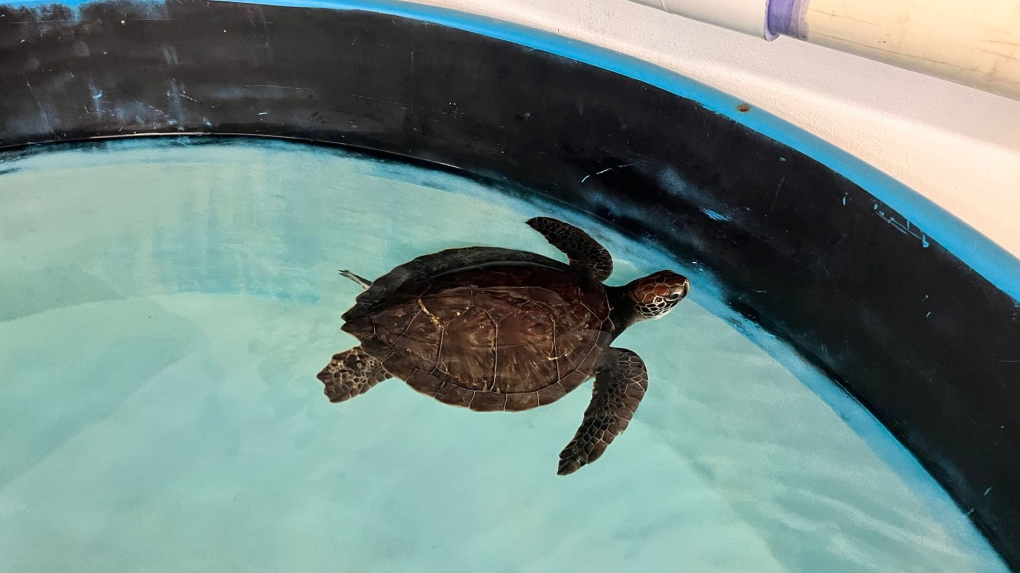An endangered green sea turtle found on a Nova Scotia beach has been revived and shipped back to warmer waters after nearly dying in the frigid Bay of Fundy.
Scottie was given her name after she was found hypothermic and semi-comatose on Nov. 16 on a beach near Scots Bay, about 100 kilometres northwest of Halifax.
Kathleen Martin, director of the Canadian Sea Turtle Network, said in an interview Friday a couple was walking on the beach when they noticed the juvenile turtle, which was about 30 centimetres wide across its hard-shelled back and weighed just over five kilograms.
At first, the rescuers thought Scottie was dead, but as they went to lift her off the sand, “she moved her head,” Martin said. The turtle was carried off the beach and brought to Dalhousie University veterinarian Chris Harvey-Clark and his wife, Patricia Pryor, also a veterinarian, for treatment.
“In 25 years, we’ve only had two turtles that have lived longer than 48 hours after being rescued from a cold-stunned situation, and she’s the second of those,” said Martin.
Martin said there are increasing instances of green sea turtles being found on Nova Scotia beaches as the Gulf of Maine to the province’s south warms and the animals follow warm currents into the colder Canadian waters.
Most don’t survive for long when they do venture this far north, she said. Scottie — described by Martin as a “robust” five-year-old — was the sole survivor of eight turtles found this month along Nova Scotia’s shores.
Harvey-Clark said in an interview that he and Pryor helped warm the turtle, which spent part of its time in the couple’s bathtub. They provided nourishment and hydration and, in preparation for her flight, gently packed her in a modified cat container — with the label “Live green sea turtle. Do not tip.”
“Rarely do we get a turtle that’s likely gonna make it,” Harvey-Clark said Friday.
“They can’t regulate their body temperature. So they’re depending on the temperature of the water around them, plus a certain amount of exercise to generate heat. And, unfortunately, when they hit about 10 C (water temperature) their ability to contract their muscles becomes impaired,” he explained.
But Scottie was in unusually good condition and, after rest and rehydration, was eager to resume swimming. The main challenge was creating a container in which she wouldn’t damage her body by repeatedly pounding her nose against the edge, he said.
Martin and Harvey-Clark said they received help from the federal Fisheries Departments and border officials, along with Air Canada, in rapidly arranging transit to Bermuda, where she has been sent to the Bermuda Aquarium Museum and Zoo. “It takes a village to save a turtle,” said Harvey-Clark.
The turtle will remain at the aquarium until she’s well enough to return to the wild, and hopefully reproduce over a lifetime that could last 75 years, he added.
Asked why so much effort should go into saving one turtle, the veterinarian said Scottie’s survival could mean she repeatedly produces offspring over the remainder of her life.
Harvey-Clark said it’s worth recalling that Scottie has faced predators from the moment she emerged from an egg and raced for the sea.
“The success rate of hatchlings in the wild is extremely low. You add to that things like fishing, which hits older, larger animals, and poaching, which still goes on all over the place … there’s an awful lot of pressure on these animals. So every single saved animal has value,” he said.
Martin said over the years she’s often felt like a “turtle coroner” as warmer water species washed ashore in Nova Scotia, and she would bring them to veterinary colleges for a necropsy to determine the cause of death.
She said the survival of Scottie has lifted her spirits.
“She’s just an incredible sign of hope against all odds, right? We all need that …. In this work, that’s what we live for.”
This report by The Canadian Press was first published Nov. 24, 2023.


